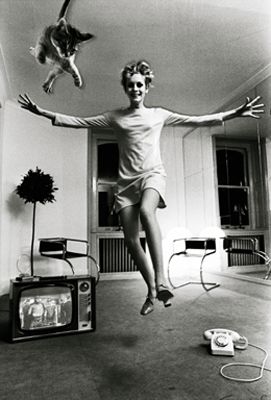Mesmo para quem adora arte, são poucas as obras que te puxam pelo braço enquanto tu anda pelo museu, apertam teus ombros, te sacudindo, olham bem na tua cara e dizem “agora tu vai ficar ali olhando para mim por um bom tempo, vai sair do museu comigo na cabeça e nunca mais vai me esquecer”.
E sabe que a gente não esquece mesmo? Pois essa aqui me segurou e me fez voltar umas três vezes para a salinha pequena em que ela estava, num canto do Whitney: A Woman in the Sun (1961), do Edward Hopper. E olha que eu nem sou muito fã do cara.
E sabe que a gente não esquece mesmo? Pois essa aqui me segurou e me fez voltar umas três vezes para a salinha pequena em que ela estava, num canto do Whitney: A Woman in the Sun (1961), do Edward Hopper. E olha que eu nem sou muito fã do cara.

Eu não vou ficar aqui falando sobre a tela, quem sou eu. Mas separei um trechinho de um texto que fala, se alguém tiver saco de ler:
“If Degas' figures represent a pure life of the senses, Hopper's women, like Homer's, represent the life of the mind, the soul, and the imagination. Though we cannot see the window through which the woman is looking in A Woman in the Sun, our eye is carried out through the window to her left to the line of hills outside of her room, as a visionary release from the physical confinements of the room and the shallow perspectival space of the painting itself. The lovely roundness and greenness of those hills (in contrast to the sharp, gray, rectilinearity of the boxlike room) is something this woman participates in, Hopper shows us in two different ways: not only by making their curves echo the curves of her breasts, buttocks, and thighs, but additionally by making the patch of floor she stands on take on the same green hues as the outdoor scene. If one wanted further confirmation of the figure's imaginative participation in the pastoral world beyond the walls of the room in which she stands, it is given by the evidence of the breeze that bathes her body (apparent in the blowing of the curtain she faces). Just as in his Evening Wind etched forty years earlier, Hopper uses the presence of the breeze, as it is represented by the movement of the curtains, to draw the mind of the viewer and the imagination of the work's figure outward, outside of her physical confinements. (This is a use of the wind in a painting that Hopper very likely learned from Homer, who does much the same thing by representing the way the breeze blows the clothing of many of his figures.)”
Ray Carney em American Vision
Ah, eu também chamaria a atenção para os sapatos ao lado da cama.


Nenhum comentário:
Postar um comentário